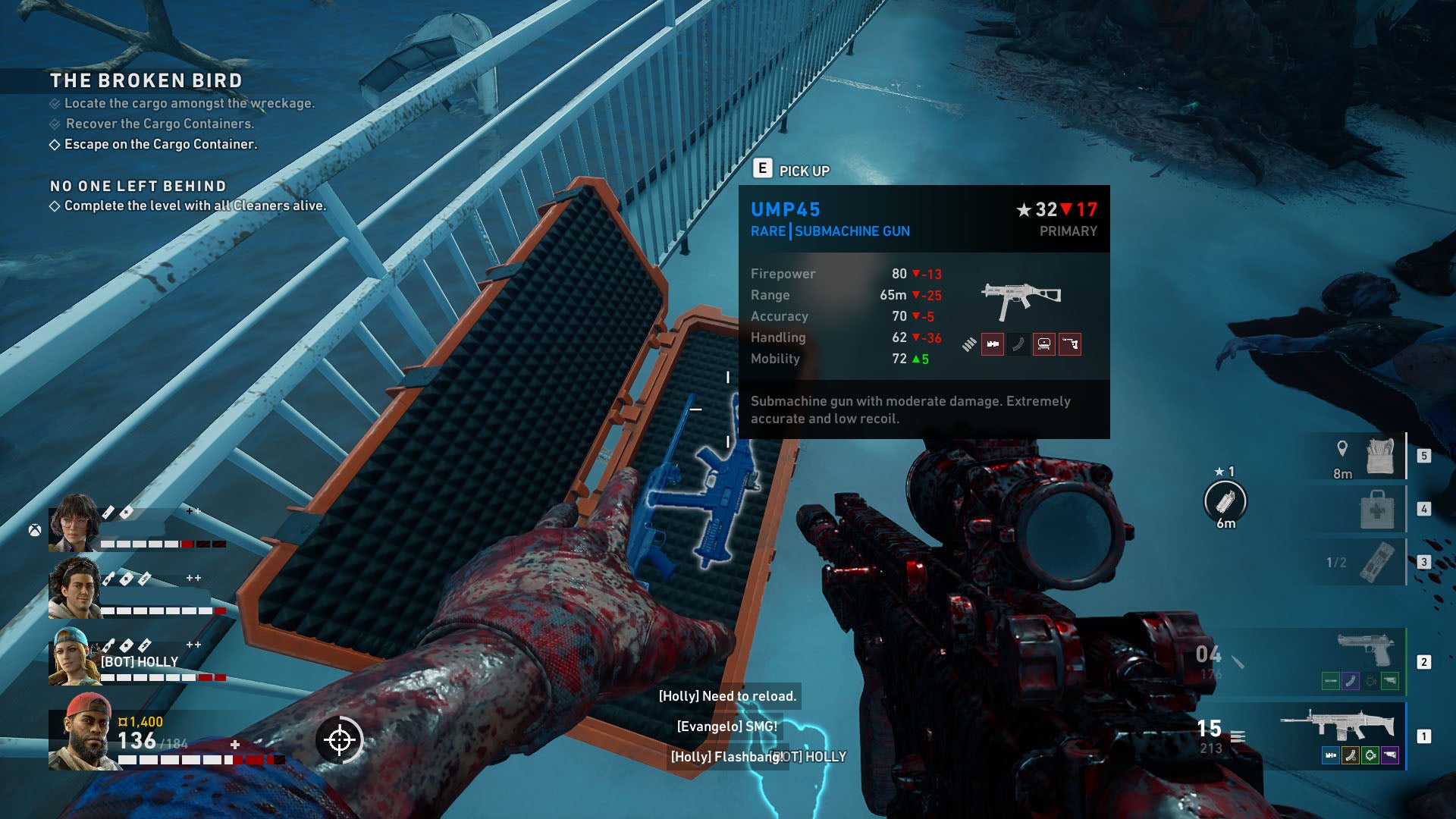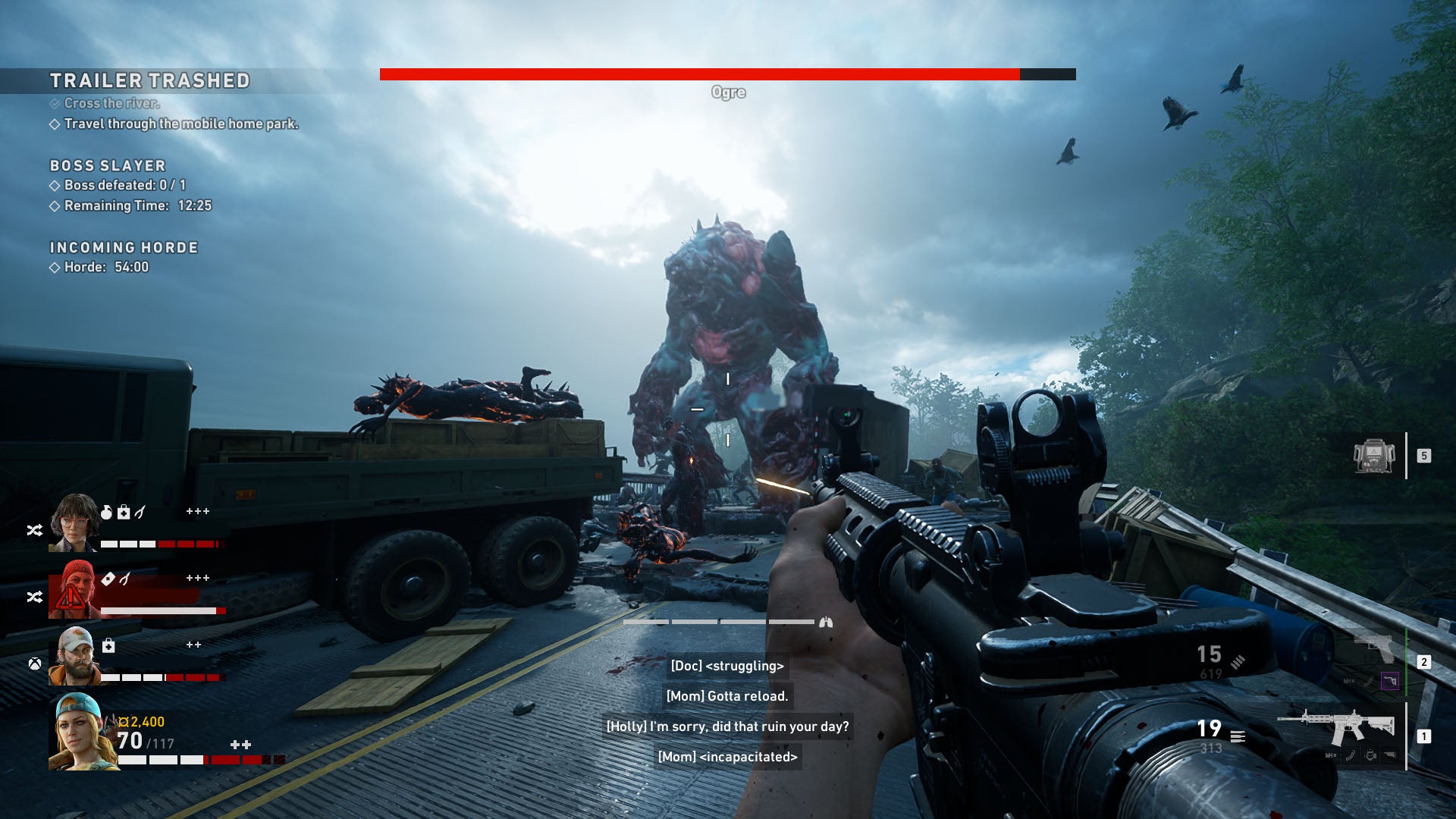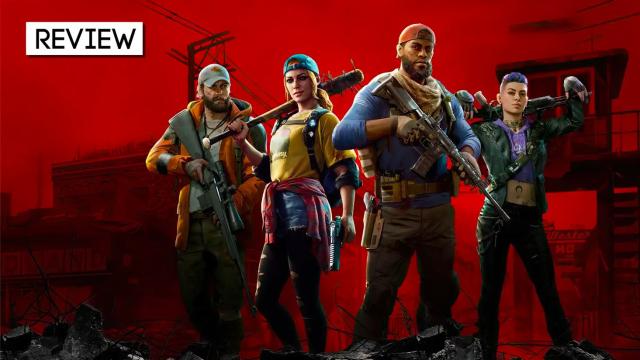Celebrated filmmaker Jim Jarmusch once said, “Originality is non-existent. And don’t bother concealing your thievery — celebrate it if you feel like it.” Back 4 Blood, a new zombie-themed co-op shooter developed by Turtle Rock Studios, sure puts this principle into practice. Even its name is a direct callback to the studio’s earlier creation, Left 4 Dead, which heavily “inspired” this game.
While Valve might own the rights to that particular shooter series, it doesn’t (as far I know) own the rights to the general concept of a zombie co-op FPS that places a focus on fast action and replayability. So that’s what Turtle Rock has effectively made: a new Left 4 Dead without any of the characters, specific enemy types, or other identifying aspects of the L4D brand. And while it doesn’t quite nail the wonderfully approachable simplicity and perfectly calibrated tension of those past games, Back 4 Blood is still a damn good time, and a treat for those who miss L4D.
Back 4 Blood is a co-op shooter set in a zombie apocalypse. It requires up to four players to work together and fight their way through zombie-infested levels, ultimately trying to reach a safe room where they can restock supplies, or an exit so they can escape the zombie hordes. Along the way, in addition to the run-of-the-mill zombies who shamble and run about each level, more dangerous infected enemies attack your group, causing a lot of problems. These special zombies have more advanced abilities, like being able to spew toxic goo at the survivors, and when you have to deal with them on top of the hundreds of common zombies you encounter everywhere, well, things get pretty chaotic. Thankfully you can also find guns, health items, useful gear, and explosives dotted around the levels.
If you’re the least bit aware of Left 4 Dead 1 or 2, a lot of this probably sounds familiar. That’s because Back 4 Blood is designed to be a spiritual successor to those popular shooters, though even the term “spiritual successor’’ undersells just how much Back 4 Blood feels, plays, sounds, and looks like Left 4 Dead. You’ve got the plethora of on-screen prompts and messages which let random players work together without mics, the array of special infected, the option to rock either a pistol or a melee weapon, big moments where players have to fend off an endless horde of zombies to progress, and even the exact same healing mechanics as Left 4 Dead, complete with pills, bandages, and first aid kits.
In other words: If you slapped Left 4 Dead 3 on the title screen, your average person who doesn’t follow video game news would probably just go, “Oh cool, a new one!” That’s a compliment to Turtle Rock Studios. A lot of devs have spent the years since Left 4 Dead trying to craft similarly fun and exciting co-op games, but most never match the success of those influential zombie shooters. It’s nice to have a co-op shooter that scratches the same itch that Left 4 Dead did. But it is so similar to those games that it naturally invites direct comparisons, and that doesn’t always play out well for Back 4 Blood.
The big difference between B4B and L4D is that Back 4 Blood has a deep progression system built around ability and item cards that you can unlock as you complete levels and then use to build decks of preferred and useful cards.
So you might unlock a card that lets you hold more shotgun ammo and deal more shotty damage too. Or a card that gives you a boost to your speed when you take damage. Or even a card that provides all your teammates with more ammo or stamina. There are a lot of cards, and building decks lets you modify the game based on how you like to play. Love to run and gun? There are plenty of cards to support that playstyle. Prefer to be a support player, keeping people alive and well-stocked on ammo? Well, lucky you; there are plenty of cards for that, too.
During campaigns, you fight your way from safe room to safe room (just like in L4D). Each time you reach one, five cards are randomly drawn from your selected deck and you choose one of those to take effect. Over the course of a campaign and its various missions, you might build up a collection of active cards that makes you more powerful, and better able to take on harder enemies and challenges. Or you might just have a crappy deck with cards that don’t synergize much, and not really gain any advantages. This is the big problem with the card system in B4B. While it does indeed give you more of a reason to keep coming back to the game, it’s also an intimidating system for newcomers, and one which I fear might put off a lot of folks right from the start.
You do get a tutorial for the whole card system, and it’s fine at explaining the basic concept. Actually unlocking cards, building a deck, and then selecting each card during missions, however, adds up to a lot of busy work. It also adds one more thing you have to explain to new players as you introduce them to the game, which can put a damper on co-op gaming sessions with friends or family members. Left 4 Dead, by contrast, is a wonderfully accessible game, one that makes it relatively easy even for non-gamers to just pick up a controller and have a great time with their friends.
Likewise, the game’s weapon attachment system is neat in theory, but in practice, it can be confusing to new players, and it slows the entire game to a crawl more often than the hordes of zombies do.

You can upgrade every gun in the game, from shitty pistols to badass assault rifles, with various attachments that you find in safe rooms or during levels. And there are a lot of them. Probably too many, honestly. You have at least three dozen scopes, magazines, barrel modifications, stocks, and other attachments. Each have their own stats and rarity levels. And each gun has its own stats and rarity levels. And all of these attachments can greatly improve the quality of a gun, or make it less useful.
For example, a powerful scope is helpful on a rifle, not so much on a shotgun. Yet, you can’t remove attachments from guns unless you find a replacement attachment, and some guns spawn with broken attachments which make the weapon worse, requiring you to replace those with better ones and … I’ve probably lost you by this point. Sorry.
That’s the thing with this attachment system: just explaining it to someone is a chore. (I left some details out, too!) Thinking about it and dealing with it while you’re playing sucks. It’s just so messy and fiddly, doubly so when you’re trying to manage all of it in the middle of a giant zombie shootout. If you choose to ignore it, though, you’ll eventually feel underpowered as you progress through the campaigns.
So, yes. At first, I hated both the cards and the attachments. It felt like someone pouring too much sugar into the perfect confection that is Left 4 Dead 2.
And yet, when I wasn’t dealing with those aspects of the game, I loved how sweet it felt to play Back 4 Blood, and eventually, it all clicked into place. I still think the attachments bog the game down as people spend too much time trying to create the perfect weapon during missions, but I get why the system exists now. And I like it. It adds an extra level of complexity and replayability to Back 4 Blood. On one mission, I found a few rare and amazing attachments in a row. I still dream fondly of the shotgun they created and all the carnage it produced.
[review heading=”Back 4 Blood” image=”https://www.gizmodo.com.au/wp-content/uploads/sites/3/2021/10/21/aebe5ab13fad662d37ed8fd6b13747e0.jpg” label1=”BACK OF THE BOX QUOTE” description1=”“Finally, Left 4 Dead 3…Wait a minute.”” label2=”TYPE OF GAME” description2=”Always-online co-op zombie shooter with card-based progression and loot.” label3=”LIKED” description3=”Feels great to play, looks nice, interesting systems that add replayability. ” label4=”DISLIKED” description4=”Card and weapon systems hard to teach and learn, reused levels, annoying difficulty spikes.” label5=”DEVELOPER” description5=”Turtle Rock Studios” label6=”PLATFORMS” description6=”PS5, PS4, Xbox Series X/S, Xbox One, PC (Played)” label7=”RELEASE DATE” description7=”October 12, 2021″ label8=”PLAYED” description8=”Over 16 hours of campaign with friends, with random players online and solo with bots. Also played about an hour of the included PVP mode but it’s awful. ” ]
However, it took hours and hours for it to truly click with me. And I just know that a lot of folks who loved Left 4 Dead aren’t going to be bothered to fiddle around with all these extra systems. I wish, desperately, that this game had a “classic mode” that turned off all the cards and attachments. That hid all the stats. Focus on just the core essence, the shooting and zombie killing, because it’s good stuff folks. Very good stuff.
Guns in Back 4 Blood feel excellent and powerful. Even some of the weaker peashooters can quickly make short work of a crowd of undead. And more powerful shotguns and rifles not only sound deadly, but they also drop zeds efficiently and satisfyingly. Moving around while fighting or exploring also feels nice, even better than the stiff feel of Left 4 Dead. You can sprint, aim down sights, and even mantle onto ledges and over fences.
However, it can be tough to enjoy all this fine zombie killin’ because Back 4 Blood sometimes overdoes it with the enemy spawns. If you play with a few friends on rookie difficulty, it’s not too bad. Yet playing alone, with random players, or on harder difficulties can be a pain in the arse. The game is quick to spawn boss enemies and special infected, often a few at the same time. And unlike Left 4 Dead which, outside of its hardest settings, felt like a well-paced roller coaster of tension, Back 4 Blood feels more like a sadistic AI relentlessly tossing sledgehammers at you. Sure, as you learn the layout of levels and get better cards, you can make progress and succeed. However, I wish the game would chill a bit and let my friends and I enjoy the moments between fights that I loved so much in Left 4 Dead.
Oh, and good luck playing with bots. While they are very polite, willing to drop ammo or health items whenever you need some, they are complete idiots who almost seem programmed to be worthless. I often saw them get stuck on walls or doorways. They would fail to revive me, too. Worst of all, I’ve seen them just stop shooting and stand in a group of zombies while they get the shit beat of them. If you plan on playing Back 4 Blood, bring at least a friend or two, or hope you find some decent random players. Don’t rely on the AI bots. They will get you killed, especially on harder difficulties.
Ultimately, I like Back 4 Blood, but I think it often gets in its own way, pulling focus away from the terrific action at its core. I think it looks and plays great. It’s just that the cards and weapon attachments, plus some reused levels and annoying difficulty spikes, make it hard to recommend without some caveats.

You are going to have to put a solid three or five hours into Back 4 Blood — earning cards, wrapping your head around attachments, and learning the flow of it all — before this zombie shooter delivers a truly enjoyable experience. That’s a lot to ask, especially compared to the simpler, more accessible design of Left 4 Dead. Back 4 Blood, by contrast, is more like a good but complicated board game that you have to spend a decent chunk of time teaching to your friends. And as in that scenario, you likely already know if Back 4 Blood is something your group of pals will be up for.
While I wish Back 4 Blood had a classic, stripped-down mode and wasn’t so annoying on harder levels, I’m still craving it. I still want to play it. I actually stopped writing this draft to load it up and play a few levels. You have to climb some hills to reach the fun summit of Back 4 Blood, but I think it’s worth it.
Still, if you just want to kill some zombies with friends and don’t want to deal with fussy card and weapon attachment systems, there’s always Left 4 Dead 2 on Steam. Both are pretty similar, from what I understand.
Back 4 Blood is out now on PC, PlayStation 5, Xbox Series X & S and Xbox One consoles.

Leave a Reply